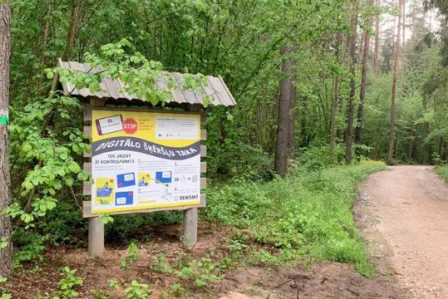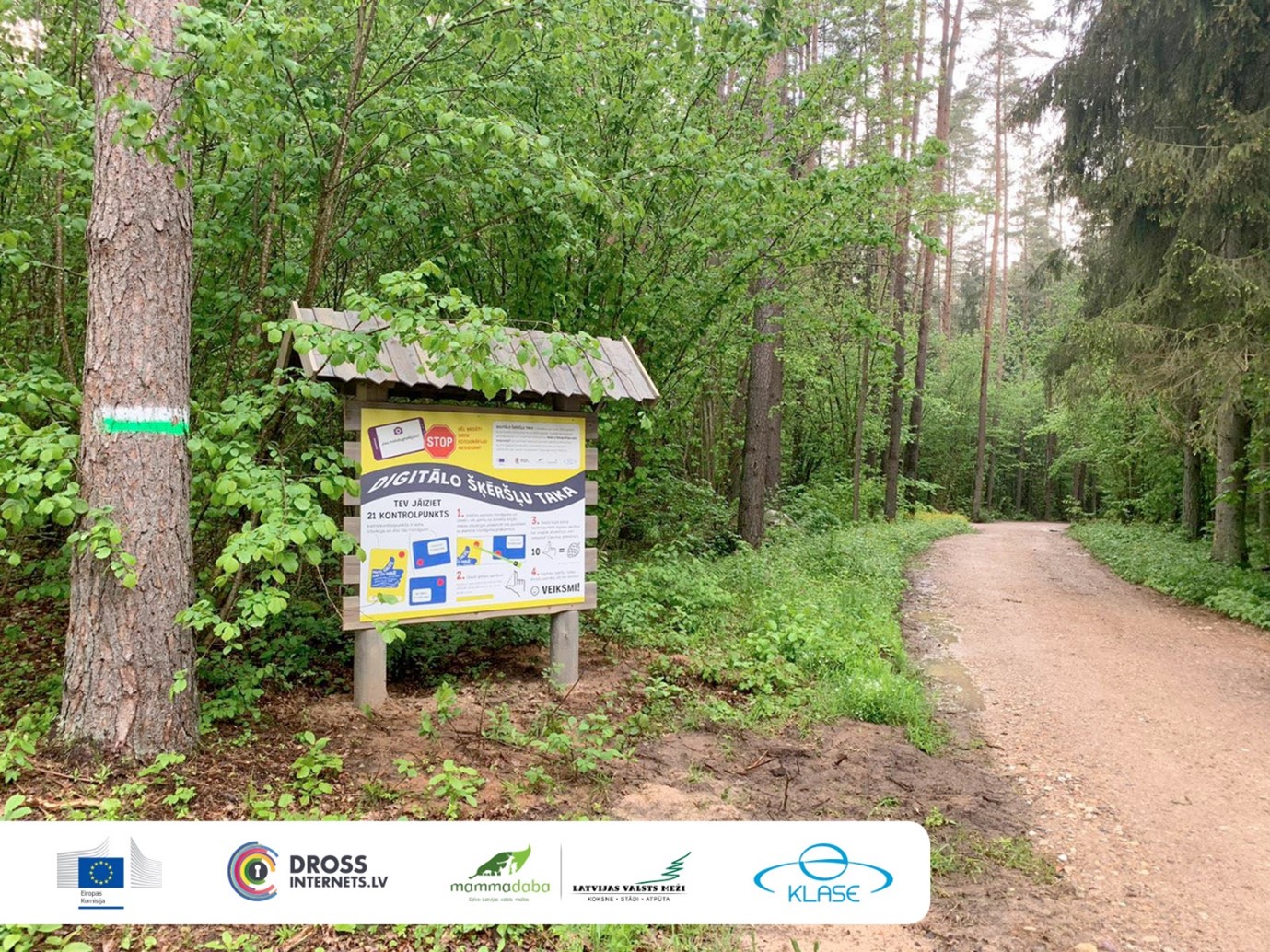On 1 June 2021, marked as International Child Protection Day for many countries, Latvia’s first digital obstacle trail was opened in a nature park “Tērvetes dabas parks” in partnership with the Latvian Safer Internet Centre (SIC) (Drossinternets.lv), the European Commission Representation in Latvia, JSC “Latvijas valsts meži” (Latvia’s State Forests), and the educational platform “E-klase.lv”.

The total length of the digital obstacle trail is 1.5 km, including 21 checkpoints with educational tasks designed to help improve both the visual and digital knowledge of students. Children are often overly focused on taking, sending and viewing photos no matter where they are and what they are doing. Therefore, this familiar activity is being used in the digital obstacle trail to provide insight into what happens with a photo and information on the internet. Within the trail, the checkpoint tasks have been developed as everyday situations with two possible courses of action from which the correct option must be chosen. The tasks include knowledge of various aspects of digital literacy, such as internet safety, respect for others, how to spot fake news, copyright, and so on. Families, as well as groups of pupils accompanied by teachers, are invited to visit the digital obstacle trail.
The digital obstacle trail was opened by planting a symbolic digital forest. “For our knowledge to grow and green like oaks in a rapidly changing world, we need to learn throughout life. A great way to learn something new and strengthen what you know is to visit the digital obstacle trail, combining a walk in nature with an exciting task. At the trail checkpoints, we encourage participants to evaluate various situations and choose the most appropriate answer for each situation. For example, ‘What would you do if, walking down a forest path, you meet a bear? Will you film it or rather save your skin?’” Maija Katkovska, head of Drossinternets.lv, commented about the new trail.
“The world-famous artist Paul Gauguin once said: ‘A meter of green is greener than a centimetre.’ The way to climate neutrality leads through knowledge, behaviour changes, and even wider use of technologies, to preserve our planet for future generations and to act smarter. For many decades, we moved in green and digital directions by centimetres, now the time has come to move faster by metres and kilometres. I hope that the trail will help both little and big ones to better understand the current processes in the world, to expand their world view, and to better understand the goals set,” Zane Petre, the Head of the European Commission Representation in Latvia, stated.
“In an ideal world, parents and educators would have the opportunity to gradually develop the skills and knowledge of children who have to perform various tasks in the digital world. Unfortunately, the reality is not always ideal and, as a result of the pandemic, the youngest children were literally thrown into a virtual whirlpool – suddenly a first-grader must not only be able to write a word but also how to press diacritic signs on the keyboard and understand that a virtual lesson is also a lesson and that not everything that can be clicked is worth clicking! We believe that exploring the digital environment would certainly be easier if the child understood the principles of operation and could associate his or her virtual steps with those being taken in a real environment. Therefore, we hope that the digital obstacle trail will help acquire these skills,” Zane Rašmane, a representative of E-klase.lv, further emphasised.
The digital obstacle trail is the first of its kind in Latvia, uniting four different partners. It is available to visitors free of charge. At the end of the trail, participants can check their results and discover the correct answers.

Latvia's first digital obstacle trail. Image copyright of the Latvian Safer Internet Centre and partners.
Find out more about the work of the Latvian Safer Internet Centre, including its awareness raising, helpline, hotline and youth participation services, or find similar information for Safer Internet Centres throughout Europe.
On 1 June 2021, marked as International Child Protection Day for many countries, Latvia’s first digital obstacle trail was opened in a nature park “Tērvetes dabas parks” in partnership with the Latvian Safer Internet Centre (SIC) (Drossinternets.lv), the European Commission Representation in Latvia, JSC “Latvijas valsts meži” (Latvia’s State Forests), and the educational platform “E-klase.lv”.

The total length of the digital obstacle trail is 1.5 km, including 21 checkpoints with educational tasks designed to help improve both the visual and digital knowledge of students. Children are often overly focused on taking, sending and viewing photos no matter where they are and what they are doing. Therefore, this familiar activity is being used in the digital obstacle trail to provide insight into what happens with a photo and information on the internet. Within the trail, the checkpoint tasks have been developed as everyday situations with two possible courses of action from which the correct option must be chosen. The tasks include knowledge of various aspects of digital literacy, such as internet safety, respect for others, how to spot fake news, copyright, and so on. Families, as well as groups of pupils accompanied by teachers, are invited to visit the digital obstacle trail.
The digital obstacle trail was opened by planting a symbolic digital forest. “For our knowledge to grow and green like oaks in a rapidly changing world, we need to learn throughout life. A great way to learn something new and strengthen what you know is to visit the digital obstacle trail, combining a walk in nature with an exciting task. At the trail checkpoints, we encourage participants to evaluate various situations and choose the most appropriate answer for each situation. For example, ‘What would you do if, walking down a forest path, you meet a bear? Will you film it or rather save your skin?’” Maija Katkovska, head of Drossinternets.lv, commented about the new trail.
“The world-famous artist Paul Gauguin once said: ‘A meter of green is greener than a centimetre.’ The way to climate neutrality leads through knowledge, behaviour changes, and even wider use of technologies, to preserve our planet for future generations and to act smarter. For many decades, we moved in green and digital directions by centimetres, now the time has come to move faster by metres and kilometres. I hope that the trail will help both little and big ones to better understand the current processes in the world, to expand their world view, and to better understand the goals set,” Zane Petre, the Head of the European Commission Representation in Latvia, stated.
“In an ideal world, parents and educators would have the opportunity to gradually develop the skills and knowledge of children who have to perform various tasks in the digital world. Unfortunately, the reality is not always ideal and, as a result of the pandemic, the youngest children were literally thrown into a virtual whirlpool – suddenly a first-grader must not only be able to write a word but also how to press diacritic signs on the keyboard and understand that a virtual lesson is also a lesson and that not everything that can be clicked is worth clicking! We believe that exploring the digital environment would certainly be easier if the child understood the principles of operation and could associate his or her virtual steps with those being taken in a real environment. Therefore, we hope that the digital obstacle trail will help acquire these skills,” Zane Rašmane, a representative of E-klase.lv, further emphasised.
The digital obstacle trail is the first of its kind in Latvia, uniting four different partners. It is available to visitors free of charge. At the end of the trail, participants can check their results and discover the correct answers.

Latvia's first digital obstacle trail. Image copyright of the Latvian Safer Internet Centre and partners.
Find out more about the work of the Latvian Safer Internet Centre, including its awareness raising, helpline, hotline and youth participation services, or find similar information for Safer Internet Centres throughout Europe.
- media literacy media education education digital skills
Related content
- < Previous article
- Next article >












